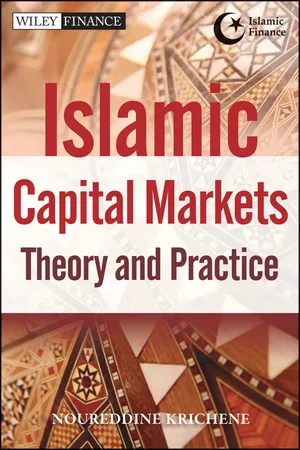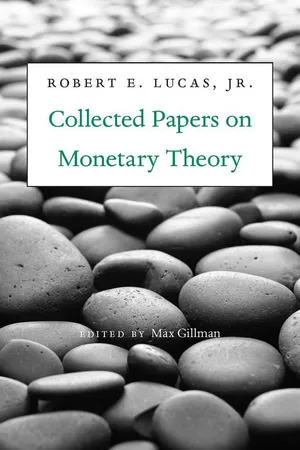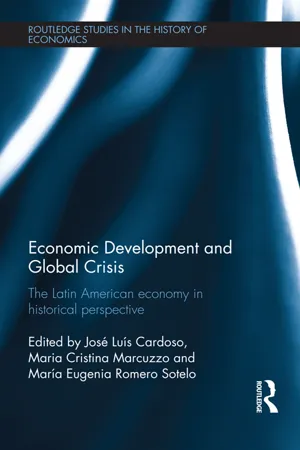Economics
Equilibrium in Money Market
Equilibrium in the money market refers to the point where the supply of money equals the demand for money. At this equilibrium, the interest rate is such that the quantity of money demanded by borrowers matches the quantity of money supplied by lenders. This balance ensures that there is no excess supply or demand for money in the market.
Written by Perlego with AI-assistance
Related key terms
4 Key excerpts on "Equilibrium in Money Market"
- eBook - ePub
Islamic Capital Markets
Theory and Practice
- Noureddine Krichene(Author)
- 2012(Publication Date)
- Wiley(Publisher)
An equilibration process will tell us how the money market actually moves to a situation where everybody manages to meet their desired behavior (given from the behavioral functions). The supply of money is the total stock of money available for use in transactions and speculation and held by the private sector. The demand for money balances is the total stock of money that the private sector wishes to hold. Note that when we change the supply of money, we are changing the amount in deposit accounts. At any instant in time, all the money has to be somewhere: every dollar of the money supply must be held by someone.If the demand for money is at M 1 there is an excess supply of money equal to M 1 − M ; private money holders would like to reduce their money balances and acquire income earning assets; there is a bond buying spree that drives up bond prices and therefore reduces interest rates; as interest rates fall, there are private money holders who might be enticed to increase their demand for cash balances. The reequilibrating process operates until equilibrium is achieved and bond and money markets are in equilibrium. In contrast if the demand for money is at M 2 there is an excess demand equal to M 2 − M ; there are private money holders who wish to increase their money holdings; they wish to sell bonds or acquire less bonds; this translates into a fall in demand for bonds, a fall in their prices, and a rise in interest rates; at higher interest rates, some private money holders may wish to reduce their demand for money in favor of income earning assets. The equilibrium process operates until equilibrium in which money and bond markets clears.Money market equilibrium is a stock equilibrium and occurs at the interest rate at which the quantity of money demanded is equal to the existing stock of money in the economy. Figure 16.1 combines demand and supply curves for money to illustrate equilibrium in the market for money. With a fixed stock of money M , the equilibrium interest rate is i - eBook - ePub
- W. Charles Sawyer, Richard L. Sprinkle(Authors)
- 2020(Publication Date)
- Routledge(Publisher)
Figure 15.4 . This equilibrium in the money market occurs as individuals and firms adjust their asset holdings. For example, at any interest rate higher than the equilibrium rate, the amount of money demanded by individuals and firms is less than the amount of money supplied. In this case, individuals and firms would buy financial assets that earn an explicit rate of return. By purchasing financial assets, the price of financial assets would rise, causing a fall in interest rates until the money market achieves equilibrium. Conversely, if the interest rate is below the equilibrium rate of interest, the amount of money demanded by individuals and firms is greater than the amount supplied. As a result, individuals and firm would sell financial assets, causing the price of such assets to fall and interest rates to rise.FIGURE 15.4The equilibrium interest rateNow that we know how the equilibrium interest rate is determined, we can illustrate how the interest rate responds to changes in either the demand or supply of money. For example, assume that the money market is in equilibrium and the real income or the price level changes. A change in either one of these determinants shifts the demand for money and changes the equilibrium interest rate. Two examples of these changes in money demand are shown in Figure 15.5 . First, assume that the money market is in equilibrium at point E, and the economy has an overall decline in real income. Such a decline in total real income is usually associated with a recession. As real income declines, the demand for money declines. This is represented by a shift in the demand for money from MD to MD1 . As a result, the new equilibrium in the money market is at F, and the equilibrium rate of interest declines to i1 - eBook - ePub
- Robert E. Lucas, Jr., Robert E Lucas, Max Gillman(Authors)
- 2012(Publication Date)
- Harvard University Press(Publisher)
This equilibrium is not a “golden rule” (a stationary state with discount factor β = 1). In contrast to optimal growth paths, however, only the stationary state can be interpreted as an equilibrium: along any approach path, an agent taking prices as given can increase his utility. This seems to me to mirror exactly Friedman’s statement, in a very similar context, that while “it is easy to see what the final position [following a change in M ] will be. .. it is much harder to say anything about the transition” (1969, p. 6). The shape of the equilibrium distribution of real balances is shown in Figure 3. There is a mass point at the institutional minimum holding y, and then a smooth distribution on. The existence of a mass point clearly follows from the economics of the situation: if individuals did not occasionally spend all available cash (return to y) they would be holding too much money. Money is an inventory, held against a particular contingency, and one never has an optimal inventory bounded away from zero. There is, however, no presumption that the lower bound y is visited “frequently” or, which comes to the same thing, that a “large” fraction of consumers will be at m = y at any point in time. Figure 3 The determinants of the demand for money, or of velocity, in this model are a mix of “institutional” and “economic” factors. Clearly, the length of a “day” will affect the equilibrium; indeed, there are economists to whom a constraint of the form pc ≤ M (in units, $/t ≤ $) must appear unthinkable. As long as one remembers not to vary the length of a “day” in mid-argument, this raises no problems, however. Moreover, the rate at which the earth rotates does have important economic implications and there is nothing to be gained in insisting on an economic explanation for this phenomenon. The economic factors affecting money demand are preferences U, the discount factor β, the volatility F of the shocks θ and income y - eBook - ePub
- José Luís Cardoso, Maria Cristina Marcuzzo, María Eugenia Romero Sotelo(Authors)
- 2014(Publication Date)
- Routledge(Publisher)
It is relevant to note that Wicksell related the desirable policy objective of price stability to undesirable effects on income distribution (Wicksell 1965: ch. 1) and later to the stabilization of business cycles.Wicksell, in developing his hypothesis, borrowed the concept of macro-economic equilibrium4 from the Austrian School of Economics (in particular from Böhm-Bawerk) and adapted it to the context of a credit-based economy with the policy objective of price stability. He advanced a monetary rule that policymakers can follow, identified as the equalization of money and the natural interest rates.In this regard, the central idea of Wicksell (1965) is that monetary equilibrium corresponds to where the ‘normal interest rate’ must equal the marginal technical productivity of real capital (natural rate of interest), guaranteeing a stable price level. In the Wicksellian explanation, both interest rates play a fundamental role. The normal/money rate is determined in the credit and money markets and it is equal to the cost of a unit of capital disposal during a unit period (Wicksell 1965). According to the central theory of prices, Böhm-Bawerk stated that the ‘natural or real’ interest rate is one in which the rate is determined by the supply and demand of real capital as it was in specie, without monetary intervention (Wicksell 1965).5Money is not a veil in a credit-based economy: It is not goods that are lent, but rather money. Then, capital represented by real goods is sold using money. Therefore, there is no need for the monetary rate to coincide with the ‘natural or real’ rate, ‘The supply of real capital is limited by purely physical conditions, while the supply of money is, in theory, unlimited and even in practice it is held within fairly elastic boundaries’ (de Aguirre 2000a: 13). Even more, in this Wicksellian world, ‘The persistence of any deviation between the two interest rates
Learn about this page
Index pages curate the most relevant extracts from our library of academic textbooks. They’ve been created using an in-house natural language model (NLM), each adding context and meaning to key research topics.



